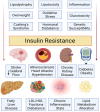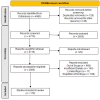Recent Advances in the Treatment of Insulin Resistance Targeting Molecular and Metabolic Pathways: Fighting a Losing Battle?
- PMID: 35454311
- PMCID: PMC9029454
- DOI: 10.3390/medicina58040472
Recent Advances in the Treatment of Insulin Resistance Targeting Molecular and Metabolic Pathways: Fighting a Losing Battle?
Abstract
Diabetes Mellitus (DM) is amongst the most notable causes of years of life lost worldwide and its prevalence increases perpetually. The disease is characterized as multisystemic dysfunctions attributed to hyperglycemia resulting directly from insulin resistance (IR), inadequate insulin secretion, or enormous glucagon secretion. Insulin is a highly anabolic peptide hormone that regulates blood glucose levels by hastening cellular glucose uptake as well as controlling carbohydrate, protein, and lipid metabolism. In the course of Type 2 Diabetes Mellitus (T2DM), which accounts for nearly 90% of all cases of diabetes, the insulin response is inadequate, and this condition is defined as Insulin Resistance. IR sequela include, but are not limited to, hyperglycemia, cardiovascular system impairment, chronic inflammation, disbalance in oxidative stress status, and metabolic syndrome occurrence. Despite the substantial progress in understanding the molecular and metabolic pathways accounting for injurious effects of IR towards multiple body organs, IR still is recognized as a ferocious enigma. The number of widely available therapeutic approaches is growing, however, the demand for precise, safe, and effective therapy is also increasing. A literature search was carried out using the MEDLINE/PubMed, Google Scholar, SCOPUS and Clinical Trials Registry databases with a combination of keywords and MeSH terms, and papers published from February 2021 to March 2022 were selected as recently published papers. This review paper aims to provide critical, concise, but comprehensive insights into the advances in the treatment of IR that were achieved in the last months.
Keywords: glucose metabolism; insulin resistance; metabolic syndrome; obesity; type 2 diabetes.
Conflict of interest statement
The authors declare no conflict of interest.
Figures



Similar articles
-
Diabetes and branched-chain amino acids: What is the link?J Diabetes. 2018 May;10(5):350-352. doi: 10.1111/1753-0407.12645. Epub 2018 Feb 13. J Diabetes. 2018. PMID: 29369529
-
Cellular Senescence in Diabetes Mellitus: Distinct Senotherapeutic Strategies for Adipose Tissue and Pancreatic β Cells.Front Endocrinol (Lausanne). 2022 Mar 31;13:869414. doi: 10.3389/fendo.2022.869414. eCollection 2022. Front Endocrinol (Lausanne). 2022. PMID: 35432205 Free PMC article. Review.
-
Associations of vitamin D with insulin resistance, obesity, type 2 diabetes, and metabolic syndrome.J Steroid Biochem Mol Biol. 2018 Jan;175:177-189. doi: 10.1016/j.jsbmb.2016.09.017. Epub 2016 Sep 20. J Steroid Biochem Mol Biol. 2018. PMID: 27662816 Review.
-
Impaired beta-cell and alpha-cell function in African-American children with type 2 diabetes mellitus--"Flatbush diabetes".J Pediatr Endocrinol Metab. 2002 Apr;15 Suppl 1:493-501. J Pediatr Endocrinol Metab. 2002. PMID: 12017222 Review.
-
Mechanisms of inflammatory responses and development of insulin resistance: how are they interlinked?J Biomed Sci. 2016 Dec 3;23(1):87. doi: 10.1186/s12929-016-0303-y. J Biomed Sci. 2016. PMID: 27912756 Free PMC article. Review.
Cited by
-
Effect of dietary approaches to stop hypertension and curcumin co-administration on glycemic parameters in polycystic ovary syndrome: An RCT.Int J Reprod Biomed. 2024 Nov 14;22(9):689-700. doi: 10.18502/ijrm.v22i9.17473. eCollection 2024 Sep. Int J Reprod Biomed. 2024. PMID: 39618714 Free PMC article.
-
Insulin Resistance, Hyperinsulinemia and Atherosclerosis: Insights into Pathophysiological Aspects and Future Therapeutic Prospects.Curr Cardiol Rev. 2025;21(1):e1573403X314035. doi: 10.2174/011573403X314035241006185109. Curr Cardiol Rev. 2025. PMID: 39415589 Review.
-
Red cell distribution width/albumin ratio as a marker for metabolic syndrome: findings from a cross-sectional study.BMC Endocr Disord. 2024 Oct 25;24(1):227. doi: 10.1186/s12902-024-01762-7. BMC Endocr Disord. 2024. PMID: 39455980 Free PMC article.
-
Gut microbiota's causative relationship with peripheral artery disease: a Mendelian randomization study.Front Microbiol. 2024 Mar 5;15:1340262. doi: 10.3389/fmicb.2024.1340262. eCollection 2024. Front Microbiol. 2024. PMID: 38505559 Free PMC article.
-
Dapagliflozin combined with metformin improves blood glucose, bone metabolism and bone mineral density in elderly patients with type 2 diabetes mellitus complicated with osteoporosis.Kaohsiung J Med Sci. 2025 Mar;41(3):e12937. doi: 10.1002/kjm2.12937. Epub 2025 Jan 15. Kaohsiung J Med Sci. 2025. PMID: 39810714 Free PMC article.
References
-
- Diabetes. [(accessed on 2 February 2022)]. Available online: https://www.who.int/news-room/fact-sheets/detail/diabetes.
-
- Courtney C.H., Olefsky J.M. Mechanisms of Insulin Action: Medical Intelligence Unit. Springer; New York, NY, USA: 2021. Insulin Resistance; pp. 185–209. - DOI
-
- Schütten M.T., Kusters Y.H., Houben A.J., Niessen H.E., Roodt J.O., Scheijen J.L., van de Waardenburg M.P., Schalkwijk C.G., de Leeuw P.W., Stehouwer C.D. Glucocorticoids affect metabolic but not muscle microvascular insulin sensitivity following high versus low salt intake. JCI Insight. 2020;5:e127530. doi: 10.1172/jci.insight.127530. - DOI - PMC - PubMed
Publication types
MeSH terms
Substances
LinkOut - more resources
Full Text Sources
Medical
Miscellaneous

